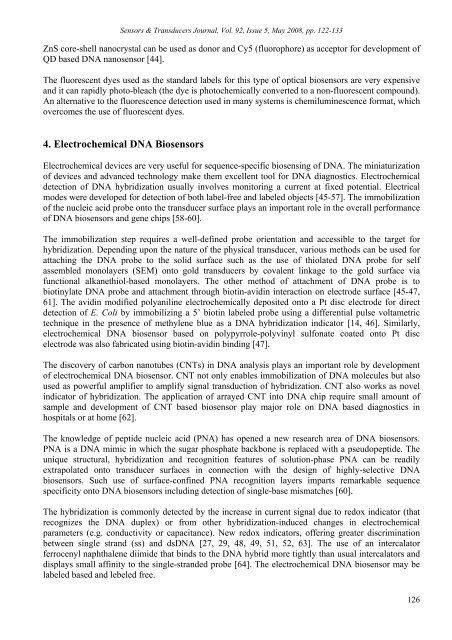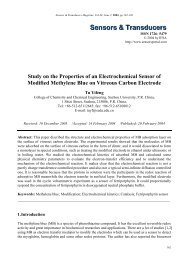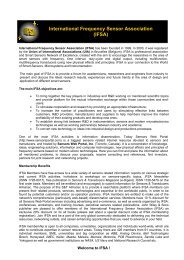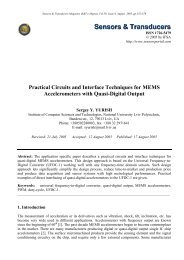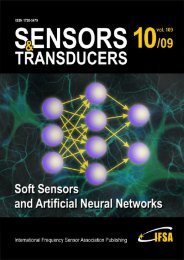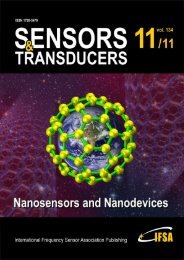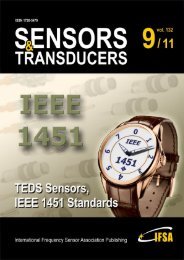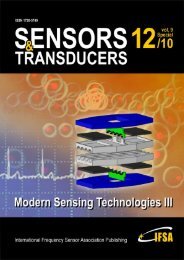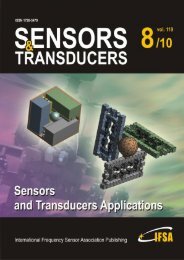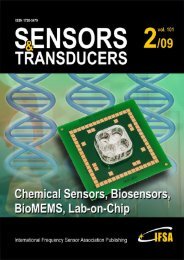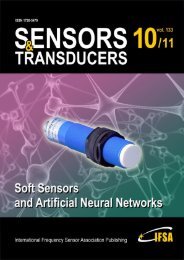Recent Advances in DNA Biosensor - International Frequency ...
Recent Advances in DNA Biosensor - International Frequency ...
Recent Advances in DNA Biosensor - International Frequency ...
Create successful ePaper yourself
Turn your PDF publications into a flip-book with our unique Google optimized e-Paper software.
Sensors & Transducers Journal, Vol. 92, Issue 5, May 2008, pp. 122-133<br />
ZnS core-shell nanocrystal can be used as donor and Cy5 (fluorophore) as acceptor for development of<br />
QD based <strong>DNA</strong> nanosensor [44].<br />
The fluorescent dyes used as the standard labels for this type of optical biosensors are very expensive<br />
and it can rapidly photo-bleach (the dye is photochemically converted to a non-fluorescent compound).<br />
An alternative to the fluorescence detection used <strong>in</strong> many systems is chemilum<strong>in</strong>escence format, which<br />
overcomes the use of fluorescent dyes.<br />
4. Electrochemical <strong>DNA</strong> <strong>Biosensor</strong>s<br />
Electrochemical devices are very useful for sequence-specific biosens<strong>in</strong>g of <strong>DNA</strong>. The m<strong>in</strong>iaturization<br />
of devices and advanced technology make them excellent tool for <strong>DNA</strong> diagnostics. Electrochemical<br />
detection of <strong>DNA</strong> hybridization usually <strong>in</strong>volves monitor<strong>in</strong>g a current at fixed potential. Electrical<br />
modes were developed for detection of both label-free and labeled objects [45-57]. The immobilization<br />
of the nucleic acid probe onto the transducer surface plays an important role <strong>in</strong> the overall performance<br />
of <strong>DNA</strong> biosensors and gene chips [58-60].<br />
The immobilization step requires a well-def<strong>in</strong>ed probe orientation and accessible to the target for<br />
hybridization. Depend<strong>in</strong>g upon the nature of the physical transducer, various methods can be used for<br />
attach<strong>in</strong>g the <strong>DNA</strong> probe to the solid surface such as the use of thiolated <strong>DNA</strong> probe for self<br />
assembled monolayers (SEM) onto gold transducers by covalent l<strong>in</strong>kage to the gold surface via<br />
functional alkanethiol-based monolayers. The other method of attachment of <strong>DNA</strong> probe is to<br />
biot<strong>in</strong>ylate <strong>DNA</strong> probe and attachment through biot<strong>in</strong>-avid<strong>in</strong> <strong>in</strong>teraction on electrode surface [45-47,<br />
61]. The avid<strong>in</strong> modified polyanil<strong>in</strong>e electrochemically deposited onto a Pt disc electrode for direct<br />
detection of E. Coli by immobiliz<strong>in</strong>g a 5’ biot<strong>in</strong> labeled probe us<strong>in</strong>g a differential pulse voltametric<br />
technique <strong>in</strong> the presence of methylene blue as a <strong>DNA</strong> hybridization <strong>in</strong>dicator [14, 46]. Similarly,<br />
electrochemical <strong>DNA</strong> biosensor based on polypyrrole-polyv<strong>in</strong>yl sulfonate coated onto Pt disc<br />
electrode was also fabricated us<strong>in</strong>g biot<strong>in</strong>-avid<strong>in</strong> b<strong>in</strong>d<strong>in</strong>g [47].<br />
The discovery of carbon nanotubes (CNTs) <strong>in</strong> <strong>DNA</strong> analysis plays an important role by development<br />
of electrochemical <strong>DNA</strong> biosensor. CNT not only enables immobilization of <strong>DNA</strong> molecules but also<br />
used as powerful amplifier to amplify signal transduction of hybridization. CNT also works as novel<br />
<strong>in</strong>dicator of hybridization. The application of arrayed CNT <strong>in</strong>to <strong>DNA</strong> chip require small amount of<br />
sample and development of CNT based biosensor play major role on <strong>DNA</strong> based diagnostics <strong>in</strong><br />
hospitals or at home [62].<br />
The knowledge of peptide nucleic acid (PNA) has opened a new research area of <strong>DNA</strong> biosensors.<br />
PNA is a <strong>DNA</strong> mimic <strong>in</strong> which the sugar phosphate backbone is replaced with a pseudopeptide. The<br />
unique structural, hybridization and recognition features of solution-phase PNA can be readily<br />
extrapolated onto transducer surfaces <strong>in</strong> connection with the design of highly-selective <strong>DNA</strong><br />
biosensors. Such use of surface-conf<strong>in</strong>ed PNA recognition layers imparts remarkable sequence<br />
specificity onto <strong>DNA</strong> biosensors <strong>in</strong>clud<strong>in</strong>g detection of s<strong>in</strong>gle-base mismatches [60].<br />
The hybridization is commonly detected by the <strong>in</strong>crease <strong>in</strong> current signal due to redox <strong>in</strong>dicator (that<br />
recognizes the <strong>DNA</strong> duplex) or from other hybridization-<strong>in</strong>duced changes <strong>in</strong> electrochemical<br />
parameters (e.g. conductivity or capacitance). New redox <strong>in</strong>dicators, offer<strong>in</strong>g greater discrim<strong>in</strong>ation<br />
between s<strong>in</strong>gle strand (ss) and ds<strong>DNA</strong> [27, 29, 48, 49, 51, 52, 63]. The use of an <strong>in</strong>tercalator<br />
ferrocenyl naphthalene diimide that b<strong>in</strong>ds to the <strong>DNA</strong> hybrid more tightly than usual <strong>in</strong>tercalators and<br />
displays small aff<strong>in</strong>ity to the s<strong>in</strong>gle-stranded probe [64]. The electrochemical <strong>DNA</strong> biosensor may be<br />
labeled based and lebeled free.<br />
126


